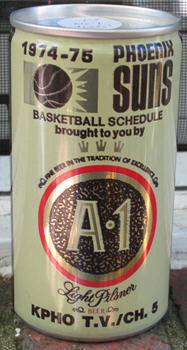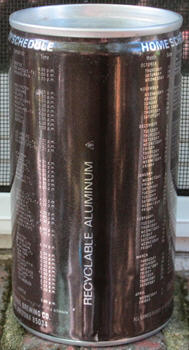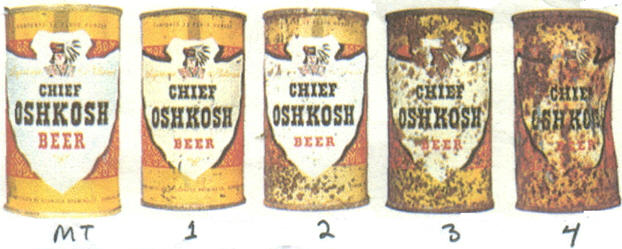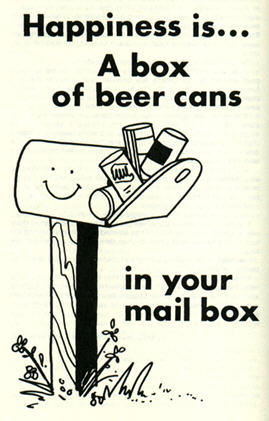A-1 Phoenix Suns Can: 1975
 |
 |
This month I am not as interested in the can itself as I am in what it represents to me personally. This was the first can I ever got via a mail trade after joining the BCCA in 1976. Mail trades are still done, but they've become a lot less common over the years, replaced by eBay and buying and selling cans. So this can represents an important part the can-collecting hobby during its height of popularity in the mid-late 1970s.
The Can
This is a bank can, not one made to hold beer. I discussed the A-1 brand--the Arizona Brewing Company's flagship--back in 2005. The brewery was sold to Carling in 1964, then bought by National in 1966. From 1975 to 1979 it was part of Carling again. In 1979 it became part of G. Heileman's brewing stable. It closed in 1985. You can read more of the history of this company in Ed Sipos' excellent article at Beerhistory.com.
FWIW the Suns went 32-50 for the year.
Trading By Mail
The Early Days and the BCCA
The BCCA's did not originally have a policy on buying/selling vs. trading. However, trading was the preferred method. However, as the hobby grew the close-knit camaraderie of the BCCA's early years naturally faded as the BCCA became a national club. Older, obsolete cans began to become more desirable as local current cans became easier to find as membership grew. And then there were several cases of what the BCCA termed "profiteering" as some members selling cans used the BCCA membership list to send out mass mailings of advertisements.
At the 1973 Canvention in Cincinnati the BCCA voted to accept a new policy banning buying and selling at official meetings, which essentially meant Canvention. In 1974 the policy was expanded to ban members using the membership roster to send out unsolicited offers to buy and sell cans. Buying and selling between members at shows was "strongly discouraged." The BCCA's justification was that buying and selling turned what was supposed to be a hobby into a business. The club also argued that buying and selling would allow members with more money to spend to buy more impressive collections than those without. There were a lot of young members of the BCCA then, kids and teens, who would not have been able to acquire as many new cans if they needed to buy them. "trade-only" remained the BCCA policy until 1982, but that discussion will come later on this page. A rival to the BCCA, the World-Wide Beer Can Collectors, formed in part as opposition to this policy, but the WWBCC was never as big as the BCCA and faded away in the early 1980s.
The problem with trade-only was, how could you set a value for a can, so that trades were "even"? What, for example, was the relative value of an obsolete can from the 1950s compared to a then-current 1970s can? The standard base value was generally accepted in the hobby at 1:1. That is, any current domestic can was the worth the same as any other current domestic can. This system was not perfect--was a can from a huge national brewery such as Schlitz, really worth the same as a can from a small regional brewery? And this doesn't even begin to scratch the depths of a discussion about "worth." Some collectables, such as coins, have a set value outside of the hobby. A nickel is always worth at least five cents, regardless of scarcity or age. And older coins made of silver have the value of the metal. But beer cans had no real "value" like a coin or an unused postage stamp. (Yes, there were some states with a can deposit, but that was only in some states, and it didn't apply to old cans). Still, the 1:1 standard did establish a baseline for collectors to use when making a trade.
Cans that were harder to get would be valued at more than 1:1. A current foreign (non-US) can was usually valued at 2:1. The person with an extra foreign can could expect to get the equivalent of two current US cans in return. If a can was valued at 3:1, then you'd get three currents in exchange for the one can, and so on. Of course a single 2:1 can was worth also another single 2:1, two 2:1 cans were worth a 4:1 and so on.
This system also several big flaws, especially as you moved away from current cans. How much value did you set on an older, obsolete can? What was a 1949 Budweiser OI worth on this scale? 20-1? 50-1? If you had a truly rare can, what was its worth--1,000:1? More? Was a 100:1 can really worth precisely twice a 50:1 can? What about dumpers?
Of course no-one with a can worth 100:1 would be willing to trade it for 100 current cans. Trading older cans was more commonly based on a like-gets-like system. If I wanted to trade a 1950s flat top, I'd expect to get another 1950s flat top in return. A 1930s can would be tradable for another 1930s can. At the time there was a mystique about cone top cans, so they were often traded only for other cone tops.
The "like-gets-like" system also had a large built-in flaw in those early days. It was easy to accidentally trade a rare can for a common can of the same vintage. I accidentally picked up one of my better Ohio cans, a Waldorf OI, that way. I don't remember that specific trade, but I suspect I traded a dumper Falls City or Sterling flat top for it. I dumped a lot of the latter cans and they traded well at shows in Ohio. It wasn't until many years later, when I started collecting again, that I pulled my Waldorf out of its box and realized what I had. It's still a fairly tough can to pick up in any sort of decent condition, while the Sterlings and Falls City cans today are very common in any condition. I wouldn't be able to trade a grade 1 of those cans for even a dumper Waldorf today. But when I made the trade in 1978 (or thereabouts) it seemed fair to both parties.
Want Ads Galore
As noted earlier, trading was an important part of the BCCA. The early issues of their magazines included a want ad section. But by the time I joined the BCCA in 1977 the want ads were in their own separate mailings. I scanned in the front and back pages of a 1976 BCCA Ad Supplement. (You can click either image to see a larger version.) The separate Want Ads section began with Issue #1 in April 1975 and lasted for 64 issues, ending in October 1982.
 |
 |
The ads are pretty straight forward. After the Beer Can Collectors' Bible and other reference books came out, however, people began referring to cans by number rather than by name. While this saved space, it ended up making the ad less useful. An ad such as "For Trade: Harvard Exports and Ales" was easier to understand than "For Trade: Bible 1269-1273. Also have 594 and 602." The latter ad lists more cans, but if I was looking for New England cans among the listings my eyes are more likely to stop scanning the ads when I saw the brand names than when they saw a row of numbers.
That raises other questions. How do you specify variations and conditions? What if your trading partner doesn't have the same reference book as you do? Are those Harvard Exports for trade the green one or the yellow/green one or the red one? Are they like new or really rusty?
There were a few solutions. The easy way, if a tad pricey, was to take photos with an Polaroid Instant or similar camera. I did that a few times. But the photos were small, so you couldn't show a lot of cans at once. And they were kind of expensive, so you might ask for them back after a trade was finished. Copying a photo of a can from a book like the Bible and putting it on your trade list also worked, but that involved a lot of cutting and pasting when that really meant using scissors and tape and not just CTRL-C, CTRL-V.
Another method was to create a grading scale that the whole hobby could adopt. The resulting scale ranking cans from 1-5 is still used today. Grade 1 is like new with few flaws, while grade 5 is mostly rust and holes. The following graphic came from the Beer Can Collector's Bible. It includes an extra grade, "Mint," for those Grade 1 cans with no flaws. It doesn't show a Grade 5 can, but you can imagine it by looking at the Grade 4 can.
 |
This scale still left a lot of wiggle room, and it's subjective enough that different collectors could easily disagree about an individual can's condition. Personal preference influenced how you judged a can. Was bubble-rust under the paint better or worse than surface rust? Did a hole on the seam change a can's desirability more or less than rust on the front? Then there was a debate over touching up or repainting cans that I discussed in my March 2012 COM. But at least if I saw a listing for a can that said "Burger Beer, Bible 422, Grade 2 " I'd have a pretty good idea what can was available.
Mail trading was fun. You'd put together a list of cans you had for trade listing condition and other notes. Then you'd send the list to prospective trading partners. A phone call could finalize a trade quickly. Otherwise you relied on sending letters back and forth. Once a trade was finalized, you'd mail the cans. That was another headache. The Post Office could easily mangle any improperly wrapped can, but it was exciting to get a package in the mail. YAY! New cans!
 |
A cartoon from the BCCA "The Beer Can." It's still true today!
Buying and Selling Come into the Open
Gradually the stigma against buying and selling cans began to fade. Some early guides, such as the Beer Can Bible, did not even list prices. The main exception to this was Beer Cans Unlimited (BCU) , which came out in 1976. It listed ranges of prices for US, and some international, cans. The original BCU was not as popular as the Bible at first, at least in part because it more more expensive, but as more editions came out the BCU became the standard reference for the hobby for twenty years.
A few professional can dealers began to do business. And as knowledge of the desirability of different cans grew, it became easier to value individual cans beyond just judging their general type. Other collectors' magazines such as Beer Cans Monthly (1978-1982) accepted ads for buying and selling and gave investment advice on cans.
By the early 1980s the collecting peak was over, and the hobby was changing. Several small brewers were marketing multiple cans meant specifically for the collector's market. Some of these infamous "70s cans" were attractive, but a lot of them were just plain ugly. A backlash against these made-to-collect cans was growing. Older cans were becoming increasingly popular and there seemed to be a little bit less emphasis on raw numbers in favor of specialization.
At the same time, pressure was growing to allow buying and selling at shows. At their August 1982 meeting the BCCA Board voted to allow buying and selling at local shows. Canvention was supposed to remain trade-only, a rule that is technically still in effect although it's been ignored for years. I don't remember how I felt about the buy/sell issue in 1982, but I was a poor grad student then with little pocket money and wasn't doing much with my collection anyway as studies took precedence.
The decision was not welcomed by everybody. It allowed can dealers to gain more of a foothold in the hobby, but it also opened another avenue in addition to dumping and trading to get cans. When eBay was launched in 1995 buying and selling was an established part of the hobby and on-line auctions became another popular way to add cans.When the BCCA released their own new reference book in 2001 for flat and conetops, it listed prices for cans, from $1.00 to $1,000+. This new book, United States Beer Cans, replaced the BCU as the standard hobby reference.
It's interesting that the rule change came about at the same time the separate want ads mailings were discontinued. I don't think this is a case of cause-and-effect as much as the two policy changes reflecting the decreasing number of collectors and the changing nature how how people acquired cans. There were fewer collectors and many (although certainly not all!) were more comfortable with buying/selling as another legitimate way to acquire cans.
Today
Today trading is still done at shows and via the mail. Email and digital cameras have made taking photos a lot easier. The Rusty Bunch holds several on-line shows for its members every year. On-line resources have severely depleted the want ads in the BCCA magazine though. Now all the want ads combined take up a half page or less in each issue.
Buying and selling cans is now much more common than trading however. It's not unusual to see someone sell some cans at a show, then rush off to buy a can from another seller with the money they just received. To be fair, a lot of this is due to increased specialization. Long time collectors often have a specific focus to their collection so it can sometimes be difficult to find a can they need in trade.
On the flip side, it's also common to see collectors set aside a few very special cans in their totes marked "trade only." I've done that with rare cans that I had a difficult time acquiring. I want to make sure I get something special in return. I'd rather trade it for another rare or special can than sell it.
The A-1
I have no idea what I traded for the A-1, but I got it from Ed Berkler in Alamogordo, New Mexico. I was dumping cans in central Kentucky at the time, so I may have traded him a dumper Falls City or Sterling. It could also have been one of the Hudepohl 1975 Cincinnati Reds World Series cans. At any rate, if Ed is still around and reads this, I still have the can!
Sources
Thank you to Kevin Kious at the BCCA for looking up some dates for me!
BCCA. The Beer Can: A Complete Guide to Beer Can Collecting. (1976).
Cady, Lew. Beer Can Collecting. (1976).
